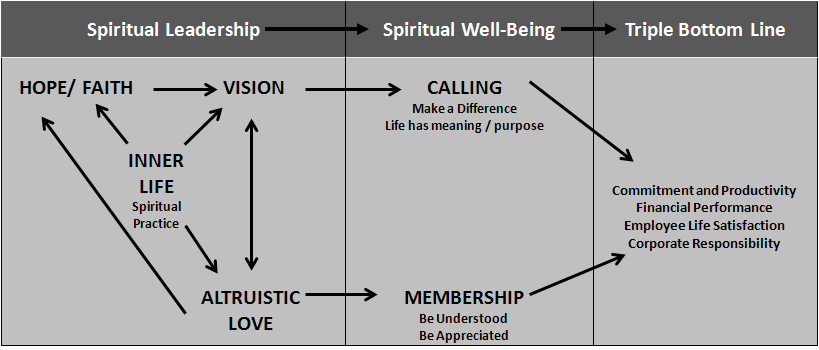Spiritual leadership involves intrinsically motivating and inspiring workers through hope/faith in a vision of service to key stakeholders and a corporate culture based on the values of altruistic love to produce a highly motivated, committed and productive workforce. The purpose of spiritual leadership is to tap into the fundamental needs of both leaders and followers for spiritual well-being through calling (life has meaning and makes a difference) and membership (belonging); to create vision and value congruence across the individual, empowered team, and organization levels; and, ultimately, to foster higher levels of employee well-being, organizational commitment, financial performance, and social responsibility – the Triple Bottom Line.
Read on to learn more about Spiritual Leadership, its core values and beliefs, and how it can benefit you.
- What is a Learning Organization?
- What is Workplace Spiritualty and how does it fit in with religion?
- How does the Spiritual Leadership Model work?
- Cultivating Personal Spiritual Leadership
- Values of Altruistic Love
- How does Spiritual Leadership Maximize the Triple Bottom Line?
- How do I implement Organizational Spiritual Leadership?
What is a Learning Organization?
Spiritual leadership is a model for organizational development/transformation designed to create an intrinsically motivated learning organization that maximizes the triple bottom line. A learning organization has the skills to create, acquire, and transfer knowledge, while modifying behavior to reflect new knowledge and insights. In learning organizations employees are empowered to achieve a clearly articulated organizational vision. Quality products and services that exceed expectations also characterize learning organizations. This new learning organizational paradigm is radically different from what has gone before: it is customer/client-obsessed, team-based, flat (in structure), flexible (in capabilities), diverse (in personnel make-up) and networked (working with many other organizations in a symbiotic relationship) in alliances with suppliers, customers/clients and even competitors.
The employees of learning organizations are characterized by being open and generous risk-takers who are capable of thinking in teams and motivating others to succeed. Furthermore, they must be able to abandon old alliances and establish new ones, viewing honest mistakes as necessary to learning and celebrating the noble effort, while exhibiting a “do-what-it-takes” attitude versus a “not-my-job” attitude. Committed leaders at all levels act as coaches who constantly strive to listen, experiment, improve, innovate, and create new leaders. The major challenge for the learning organization is developing, leading, motivating, organizing, and retaining people to be committed to the organization’s vision, goals, and culture.
Take a minute and see if your company is a learning organization by answering the following questions:
- Do you have an emotional bond with your stakeholders? Companies that prosper over the long term exude genuine affection for their customers and employees by providing a feeling of membership so that individuals feel understood and appreciated.
- Are you a fun place to work? The most productive companies tend to be the most playful. You don’t have to be downbeat to be disciplined. People are committed to an organization where they feel like part of the family and are highly regarded by leadership.
- Are you built to change? The only certainty in business today is that change must become a core capability in organizations that prosper over the long term. The best organizations may look to the past as a source of inspiration, but they don’t allow it to become an excuse for a lack of change. Instead, they pursue future productivity through the implementation of innovative strategies.
- Do you embrace the value of values? Today, more than ever, stakeholders demand to know; What values do you stand for? The company with the clearest sense of purpose wins. The heart of an organization’s success must include altruistic love – a sense of wholeness, harmony, and well being embraced through care, concern, and appreciation of both self and others.
- Are you as disciplined as you are creative? In successful organizations there is no contradiction between creativity and execution. Indeed, the most innovative companies tend to be the most disciplined through a clear and compelling vision.
- Do you use technology to change expectations and reshape your business? The Internet has become the most powerful tool for business experimentation ever. It transforms the learning organization – how people work together and how organizations interact with customers. There is no hope/faith in the economics of an organization disrupted by the fear-led, bureaucratic, hierarchy that can’t keep pace in this chaotic Internet-driven environment.
- Have you built a company of leaders? The organizations with the most confident and committed leaders, deepest in the ranks – Win! A learning organizations creates empowered teams and gives them the resources and freedom to maneuver outside the established hierarchy. It pushes decision-making authority deep into the ranks, providing employees with a sense of purpose and belonging. In doing so everyone has the opportunity to lead to the point that the distinction between leader and follower becomes blurred.
If you answered no to any of these questions, keep reading.
What is Workplace Spiritualty and how does it fit in with religion?
A person’s spirit is the vital principle or animating force traditionally believed to be the intangible, life-affirming force within all human beings. It is a state of intimate relationship with the inner self of higher values and morality as well as recognition of the truth of the inner nature of others. Today many individuals are struggling with what their spirituality means for their work since this is where they spend vast majority of their waking hours. The office is now where more and more people eat, exercise, date, drop their kids, and even nap. Many naturally look to their organizations as a communal center because they lack the continuity and connection found in other settings. Moreover, recent polls have found that American managers and leaders want a deeper sense of meaning and fulfillment on the job – even more than they want money and time off.
A Call for Workplace Spirituality
Because of this, a major change is taking place in the personal and professional lives of leaders as many of them more deeply integrate their spirituality and their work. Many agree that this integration is leading to very positive changes in their relationships and their effectiveness. There is also evidence that workplace spirituality programs not only lead to beneficial personal outcomes such as increased job satisfaction, and commitment, but that they also deliver improved productivity and reduce absenteeism and turnover. Employees who work for organizations they consider to be spiritual are less fearful, more ethical, and more committed. And, there is mounting evidence that a more humane workplace is more productive, flexible and creative. Most importantly for organizational effectiveness is the emerging research that that workplace spirituality could be the ultimate competitive advantage. Because of this, there is an emerging and accelerating call for spirituality in the workplace.
Workplace spirituality is not about religion or conversion, or about accepting a specific belief system. Spirituality at work is about leaders and followers who understand themselves as spiritual beings who have a sense of calling that provides meaning and purpose for their lives. It is also about membership where people experience a sense of belonging, connectedness to one another and their workplace community. It begins with the acknowledgement that people have both an inner and an outer life and that the nourishment of the inner life can produce a more meaningful and productive outer life that can have beneficial consequences for employee well-being, corporate responsibility and sustainability, as well as financial performance – The triple bottom line.
Religion and Spirituality
The respected Dalai Lama, in Ethics for the New Millennium, speaks to the relationship between spirituality and religion.
Religion I take to be concerned with faith in the claims of one faith tradition or another, an aspect of which is the acceptance of some form of heaven or nirvana. Connected with this are religious teachings or dogma, ritual prayer, and so on. Spirituality I take to be concerned with those qualities of the human spirit—such as love and compassion, patience tolerance, forgiveness, contentment, a sense of responsibility, a sense of harmony—which brings happiness to both self and others.
Spirituality as manifested through these qualities provides the foundation for most, if not all, of the world’s spiritual and religious traditions. Both non-denominational spiritual practices and world religions all are fundamentally based on hope/faith in a vision of love and service of others. This explains what some people and organizations (e.g., Alcoholics Anonymous) mean when they claim to be spiritual and not religious. Consequently, spiritual leadership can be implemented and practiced with or without religious theory, beliefs, and practices. In our work on leadership we have chosen to use the term spirituality to allow for its application to any organization interested in implementing workplace spirituality. However, this is in no way meant to imply that nondenominational or nontheistic spiritual practices are superior to the religious traditions and their beliefs and practices.
How does the Spiritual Leadership Model work?
Spiritual leadership is an emerging paradigm within the broader context of workplace spirituality designed to create an intrinsically motivated, learning organization. Spiritual leadership comprises the values, attitudes, and behaviors necessary to intrinsically motivate one’s self and satisfy fundamental needs for spiritual well-being through calling and membership, which positively influences employee well-being, sustainability and corporate social responsibility, and financial performance – the Triple Bottom Line.
Essential to spiritual leadership is:
- Creating a vision wherein leaders and followers experience a sense of calling so that their lives have purpose, meaning and makes a difference, and
- Establishing a organizational culture based on the values of altruistic love whereby leaders and followers have a sense of membership, feel understood and appreciated, and have genuine care, concern, and appreciation for BOTH self and others.
As shown in the figure below, the source of spiritual leadership is an inner life or spiritual practice, such as spending time in nature, prayer, religious practice, meditation, reading, yoga, or writing in a journal. An inner life practice positively influences spiritual leadership through the development of hope and faith in a transcendent vision of service to key stakeholders that keeps followers looking forward to the future. Hope/faith in a clear, compelling vision produces a sense of calling – that part of spiritual well-being that gives one a sense of making a difference and, therefore, that one’s life has meaning. Spiritual leadership also requires that the organization’s culture be based on the values of altruistic love. Leaders must model these values through their attitudes and behavior, which creates a sense of membership – that part of spiritual well-being that gives one a sense of being understood and appreciated. The dimensions of spiritual leadership and the process of satisfying spiritual needs then positively influence the key individual and organizational outcomes that comprise the Triple Bottom Line.
The Organizational Spiritual Leadership Model

